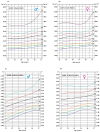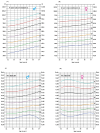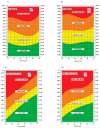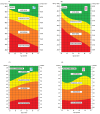Investigation of Underlying Association between Anthropometric and Cardiorespiratory Fitness Markers among Overweight and Obese Adolescents in Canada
- PMID: 38673321
- PMCID: PMC11049930
- DOI: 10.3390/ijerph21040408
Investigation of Underlying Association between Anthropometric and Cardiorespiratory Fitness Markers among Overweight and Obese Adolescents in Canada
Abstract
Background: Adolescents who experience overweight or obesity commonly persist in these conditions into adulthood, thereby elevating their vulnerability to health issues. The focus of this study is on health risk markers such as body mass index (BMI), waist circumference (WC), waist-to-height ratio (WHtR), body surface area (BSA), and cardiorespiratory fitness (CRF). The objectives include updating normative values for BMI, WC, WHtR, and BSA in Canadian adolescents, establishing cardiometabolic risk zones, and developing a composite score considering both anthropometric and CRF markers.
Methods: Involving 1864 adolescents, the study used the LMS method to generate percentile norms, stratified by age and sex. Cardiometabolic risk zones were established for each marker based on Z-scores, and a composite score was created.
Results: An increase in WC of 5.8 and 7.4 cm for boys and girls, respectively, was observed since 1981. Forward multiple regression analyses were conducted to assess the robustness and validity of the proposed model. The results indicated that the model explained nearly 90% (R2 = 0.890) of the common variance between the composite score and the retained independent variables. Moreover, the model demonstrated a mean absolute error (MAE) of approximately 6 percentiles, confirming its high precision. Furthermore, these analyses yielded key thresholds for identifying adolescents at risk: the 70th percentile for high cardiometabolic risk and the 85th percentile for very-high risk.
Conclusions: Individually, WC or WHtR seem to be better markers for evaluating cardiometabolic risk than BMI during adolescence. However, CRF showed comparable importance to anthropometric markers in determining cardiometabolic risk. The simultaneous inclusion of anthropometric and CRF markers provides a better picture of the global cardiometabolic risk in adolescents.
Keywords: VO2peak; body composition; cardiometabolic risk; maximal functional aerobic power; youth.
Conflict of interest statement
The authors declare that they have no competing interests.
Figures






Similar articles
-
Anthropometric Profile, Overweight/Obesity Prevalence, and Socioeconomic Impact in Moroccan Children Aged 6-12 Years Old with Autism Spectrum Disorder.Int J Environ Res Public Health. 2024 May 24;21(6):672. doi: 10.3390/ijerph21060672. Int J Environ Res Public Health. 2024. PMID: 38928918 Free PMC article.
-
Association between cardiorespiratory fitness and cardiometabolic risk factors in Brazilian children and adolescents: the mediating role of obesity parameters.Paediatr Int Child Health. 2021 May;41(2):93-102. doi: 10.1080/20469047.2020.1838758. Epub 2020 Oct 28. Paediatr Int Child Health. 2021. PMID: 33112727
-
Cardiorespiratory Fitness Normative Values in Latin-American Adolescents: Role of Fatness Parameters.Int J Environ Res Public Health. 2019 Oct 14;16(20):3889. doi: 10.3390/ijerph16203889. Int J Environ Res Public Health. 2019. PMID: 31615052 Free PMC article.
-
Diagnostic accuracy of anthropometric indices for discriminating elevated blood pressure in pediatric population: a systematic review and a meta-analysis.BMC Pediatr. 2022 Jan 4;22(1):19. doi: 10.1186/s12887-021-03062-8. BMC Pediatr. 2022. PMID: 34983442 Free PMC article.
-
Novel e-Health Applications for the Management of Cardiometabolic Risk Factors in Children and Adolescents in Greece.Nutrients. 2020 May 12;12(5):1380. doi: 10.3390/nu12051380. Nutrients. 2020. PMID: 32408523 Free PMC article. Review.
Cited by
-
Anthropometric Profile, Overweight/Obesity Prevalence, and Socioeconomic Impact in Moroccan Children Aged 6-12 Years Old with Autism Spectrum Disorder.Int J Environ Res Public Health. 2024 May 24;21(6):672. doi: 10.3390/ijerph21060672. Int J Environ Res Public Health. 2024. PMID: 38928918 Free PMC article.
-
The Protective Role of Physical Fitness Level Against Obesity and Body Dissatisfaction in French-Canadian Youth.J Funct Morphol Kinesiol. 2025 Jan 26;10(1):46. doi: 10.3390/jfmk10010046. J Funct Morphol Kinesiol. 2025. PMID: 39982286 Free PMC article.
-
Development of a Smart Health Care Service Using Metaverse and Chatbot Technologies for Adolescents, Parents, and School Health Teachers: User-Centered Design Approach.J Med Internet Res. 2025 Jul 3;27:e69190. doi: 10.2196/69190. J Med Internet Res. 2025. PMID: 40607742 Free PMC article.
References
-
- Cornier M.-A., Després J.-P., Davis N., Grossniklaus D.A., Klein S., Lamarche B., Lopez-Jimenez F., Rao G., St-Onge M.-P., Towfighi A., et al. Assessing adiposity: A scientific statement from the American Heart Association. Circulation. 2011;124:1996–2019. doi: 10.1161/CIR.0b013e318233bc6a. - DOI - PubMed
Publication types
MeSH terms
Grants and funding
LinkOut - more resources
Full Text Sources

